As I’d recently written an article on Shenandoah sparkling wines, I felt it only proper I do some in-depth ‘research’ on the topic.
Many Virginia wineries offer a sparkling wine, but no other Virginia wine region has embraced bubbly with the same vigor as the Shenandoah Valley. Around half of the valley’s wineries make a sparkling wine, many using the same méthode champenoise (aka the traditional method) process found in Champagne.
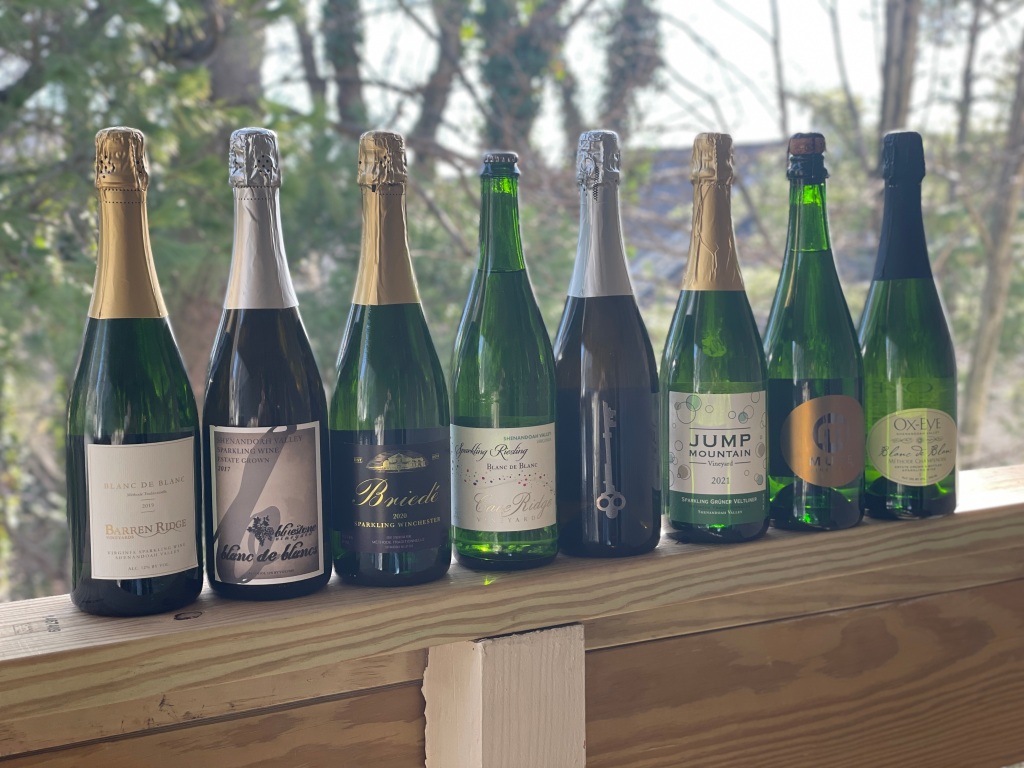
Sparkling wine pairs well with the region’s terroir. Shenandoah Valley vineyards are often located at relatively higher altitudes, which allows for greater diurnal temperature shifts. This allows grapes to maintain their acidity, one of the key components of sparkling wine.
Shenandoah Valley vineyards also benefit from what Linden winemaker Jim Law would call a strong ‘water to vine relationship’. Virginia vineyards often struggle with excess moisture, which not only lower wine quality but spark disease pressure. But grapes grown in the Shenandoah benefit from well-drained limestone soils, as well as lower overall rainfall (thanks to surrounding mountains which block incoming rainclouds).
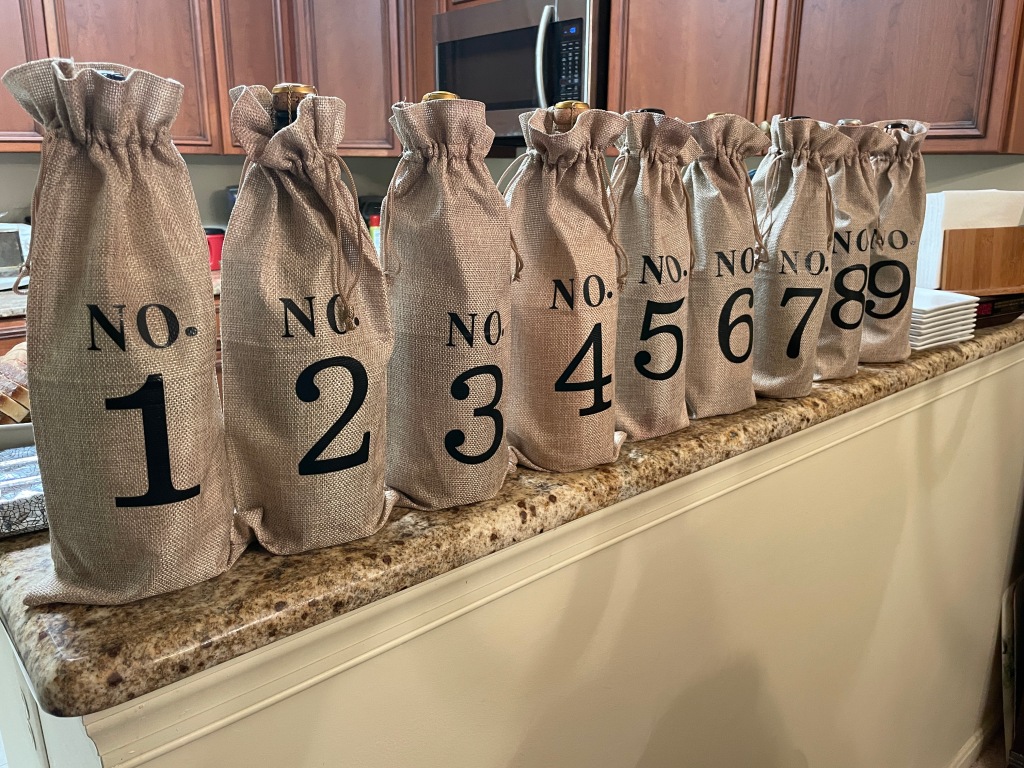
Tasting & Scoring Methodology
A group of friends & I blind tasted 9 wines in 3 flights. All the flights were bagged blind.
We didn’t have a fancy scoring system. The goal was to pick a ‘favorite’ every round, as opposed to rating them and determining the one we thought was the ‘best’. Often the best indicator of a favorite was simply seeing which bottles people selected first for refills.
The favorite of every round went to a second ‘finalist’ round with the top 3 wines. After finishing the finalists, we unveiled all the wines and crowned the overall favorite of the day.
While all my events include wine lovers, this particular one was something of the “A Team” of my wine-tasting friends. All had extensive industry experience, or at a minimum a very experience palate.
That said, only a few had a deep familiarity with Virginia wine, and even fewer were familiar with the Shenandoah Valley in particular. That made for an exciting tasting since I specifically wanted to see how Virginia wine would fare in an audience who might not otherwise have tried these bottles.
This time I changed up my usual format by pre-selecting all the wines myself (almost half were gifted by their respective winery for this event; thank you Briedé Family Vineyards, Rockbridge Vineyard, Muse Vineyards, Jump Mountain Winery, and Cave Ridge Vineyard) instead of asking by guests to bring something.
My guests only knew an overview of the theme of the day. Except for our starter wine from Cave Ridge, everything we tried was made in the traditional method.
The Contenders:
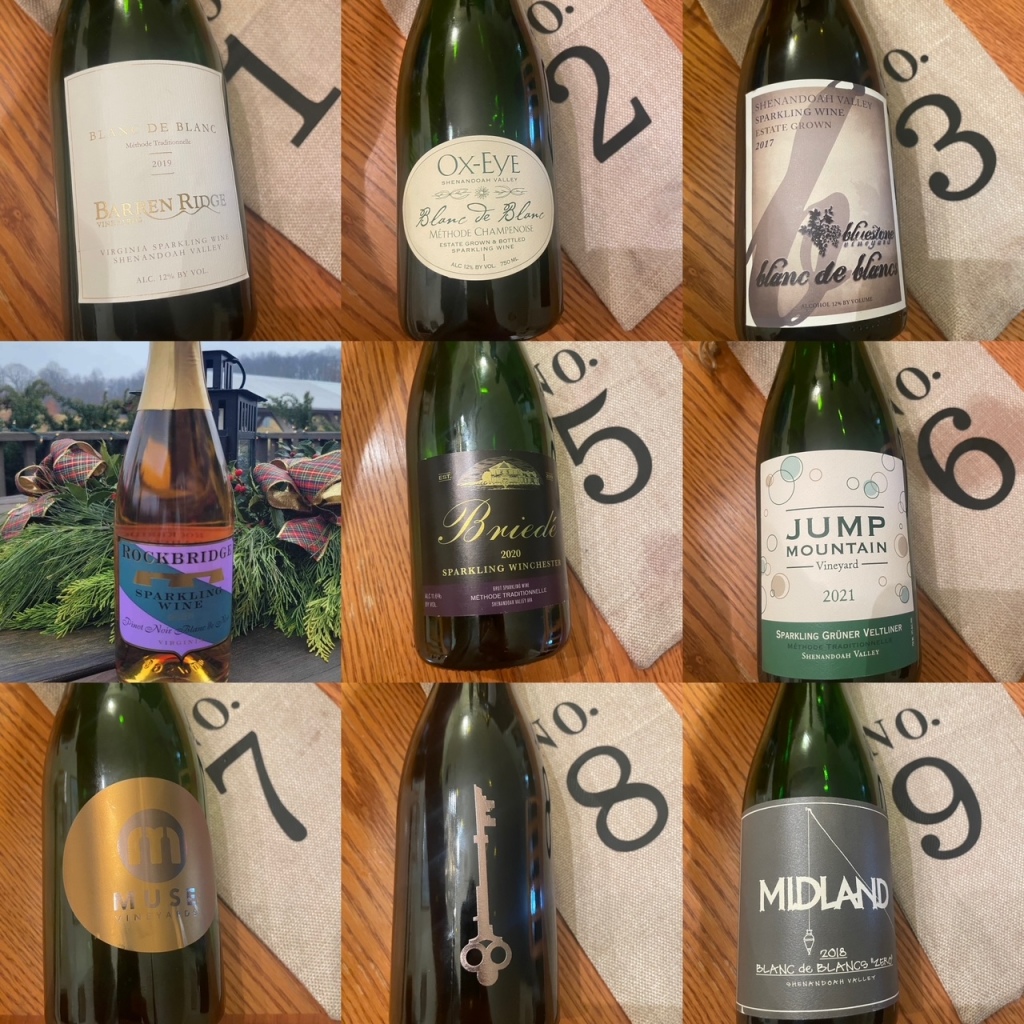
- Barren Ridge 2019 Blanc de Blanc (Chardonnay) ($35-40?)
- Ox Eye NV Blanc de Blanc (Chardonnay) ($35)
- Bluestone 2017 Blanc de blanc (Chardonnay) ($34.50)
- Rockbridge 2020 Blanc de Noirs (Pinot Noir) ($35)
- Briedé 2020 Sparkling Winchester (Cayuga) ($57).
- Jump Mountain 2021 Grüner Veltliner ($30)
- Muse NV Blanc de Blanc (Chardonnay) ($35?)
- CrossKeys 2019 Blanc de Noirs (Pinot Noir) ($38)
- Midland Wine 2018 “Zero” Blanc de Blanc (Chardonnay) ($45)
We also kicked things off with a Cave Ridge NV Sparkling Riesling, made in the Charmat method. Very bright & tart! Lots of apple notes.
Round 1 / Flight #1:
- Bottle #1: Barren Ridge 2019 Blanc de Blanc
- Bottle #2: Ox Eye NV Blanc de Blanc
- Bottle #3: Bluestone 2017 Blanc de blanc (Round winner)
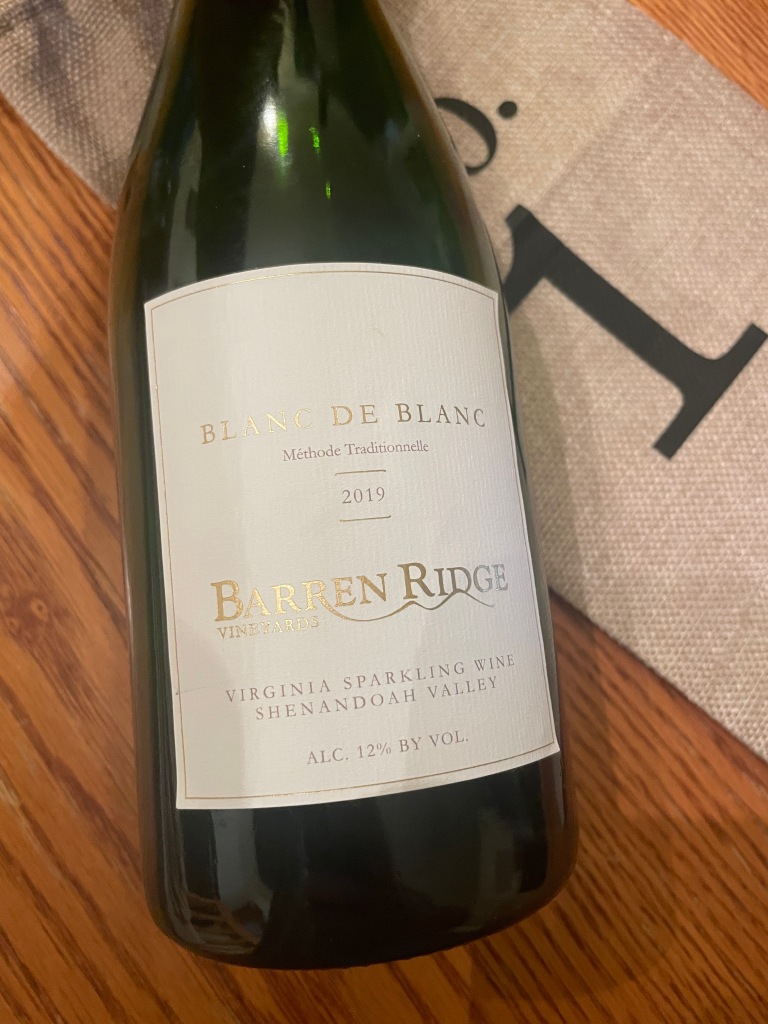
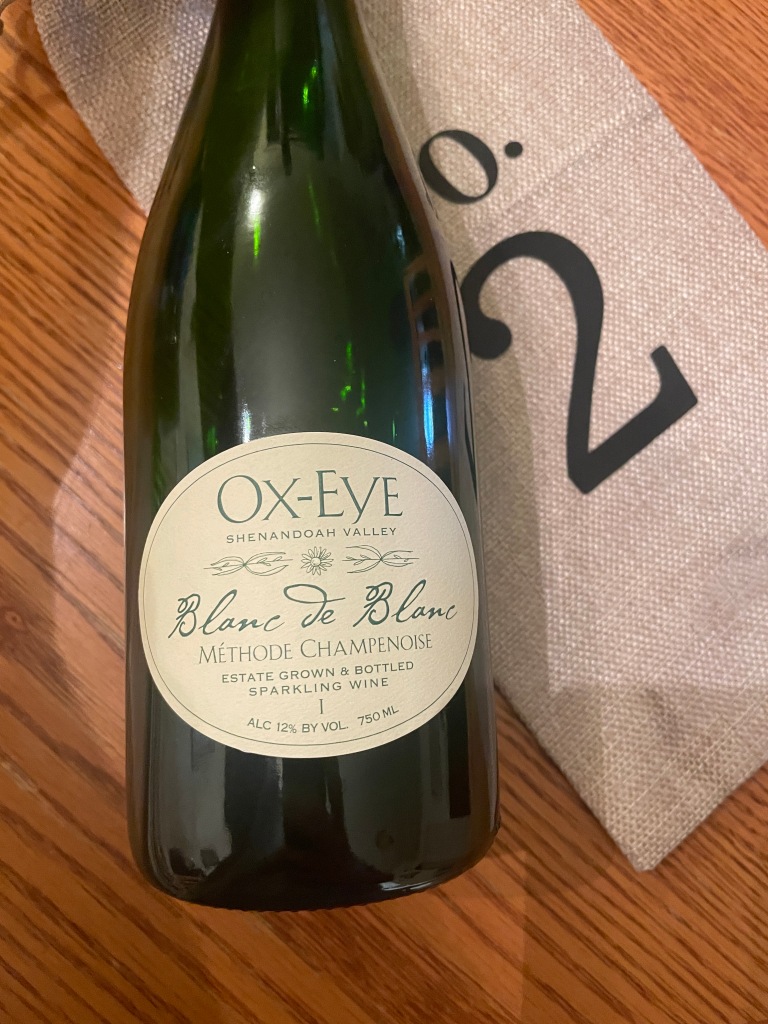
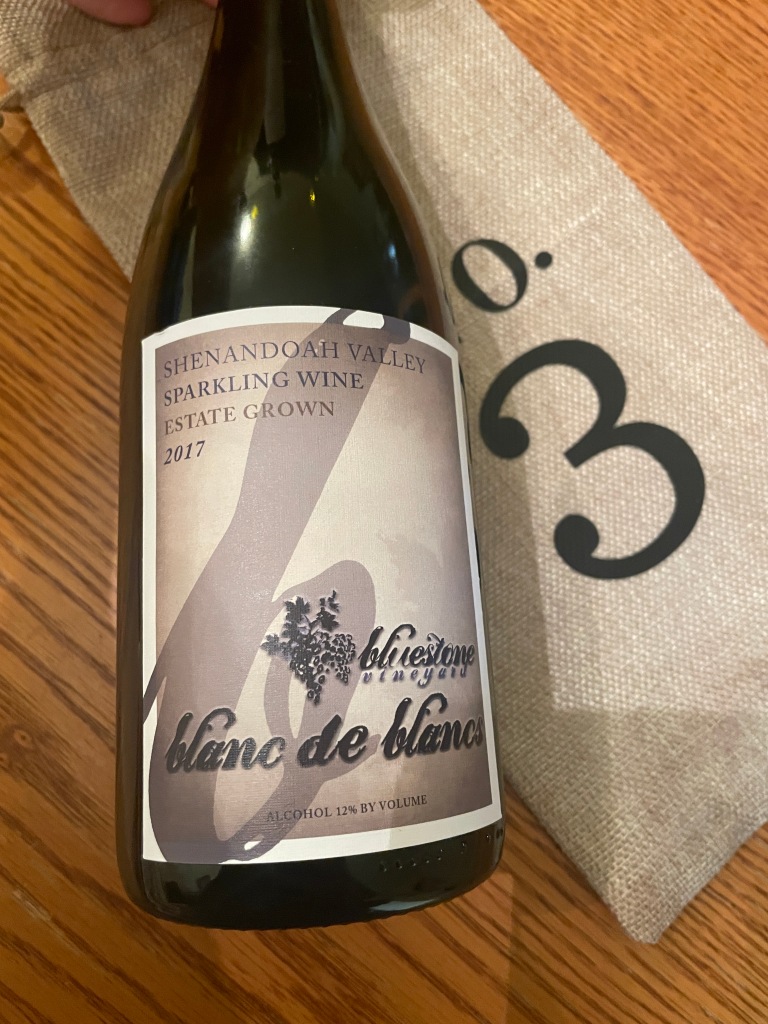
By coincidence, we had three Blanc de Blancs back-to-back. As I had a newer group I kept the tasting dialogue going on for longer than I normally do, so my notes in this round are more extensive than later ones.
In terms of style and especially color, all three were fairly closely matched.
This round became a duel between smoothness (#2/Ox Eye) and complexity (#3/Bluestone). Eventually, Bluestone’s complexity won. That said, the first one from Barren Ridge was also well enjoyed, so being most people’s 3rd pick wasn’t an indication people didn’t like it.
Bottle #1: Barren Ridge 2019 Blanc de Blanc: Our tasting notes were largely centered on citrus notes, especially lemon and green apple. Someone mentioned it had some Malo, which made sense as another taster commented they got some slight butter notes.
There was disagreement about how much minerality it had, with some not being able to detect it and others saying it was there. An overall pleasant wine.
Bottle #2: Ox Eye NV Blanc de Blanc: Someone noted this may have been the most champagne-like of the lineup. Some weight and toastiness; notes of lemon, green apple, and orange peel were mentioned. One person mentioned grapefruit pith, another said it was “grippy”, even a little tannic. It may have had a little RS.
Notes on acidity were all over the place with some saying it was round and others saying it was acidic. My favorite descriptor was it tasted like an ‘abstract painting’.
Bottle #3: Bluestone 2017 Blanc de Blanc: Lots of fruit on the nose and palate. Someone mentioned it had a jolly rancher quality to it but not sweet, perhaps even bretty. Another participant said they found an herby-spice note. The general consensus was this was the most complex of this lineup.
We didn’t know it at the time, but this was the oldest vintage of the entire event. You could tell the difference in the complexity.
Votes:
- Alex: 3/2/1: Thought #3 was the most complex, while #2 was the smoothest.
- Chrisa: 2/3/1: Liked the complexity of #3 but gravitated towards #2.
- Kathy 2/3/1: Thought all of them were clean. Thought #2 was well balanced but #3 was complex.
- Lieven: 3/2/1. Thought #3 had the most depth; found notes of butter toast, peaches, and white blossom. Thought #1 was subdued but also found citrus notes.
- Matt: 2/3/1:
- Richard: 3/1/2: Liked the fruit and brioche notes of #1 but liked the brightness and acidity of #2.
- Sharneen: 2/1/3. Gravitated towards #2 as it was the most champagne-like and felt it was easy sipping.
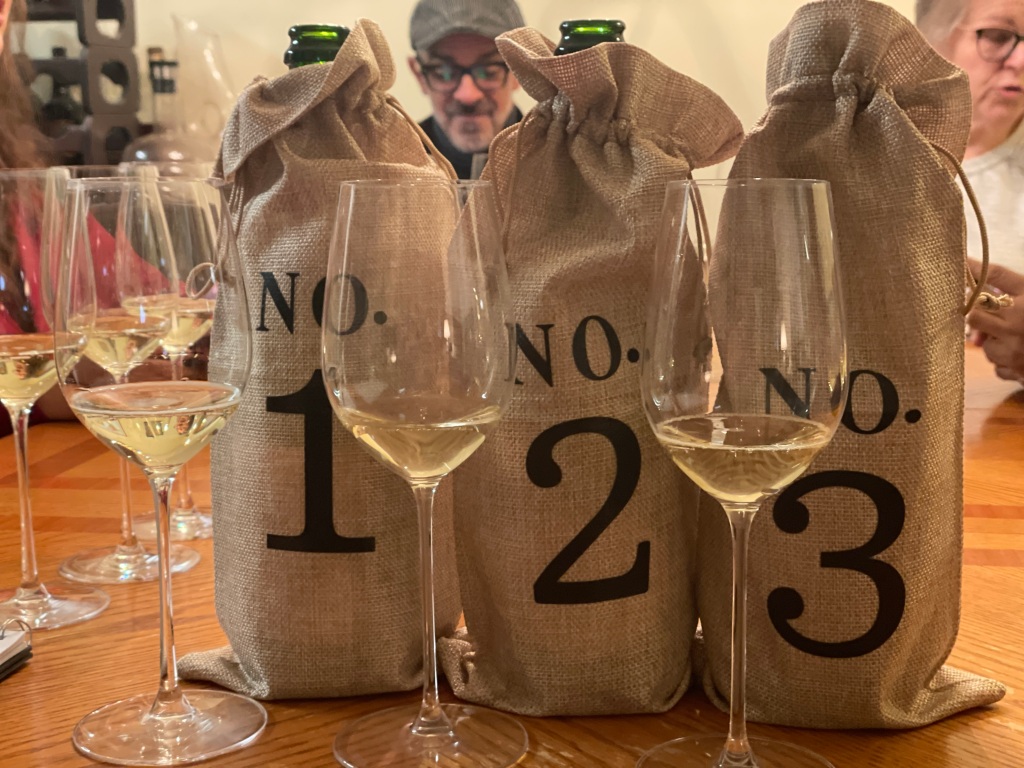
Round 1 / Flight #2:
- Bottle #4: Rockbridge 2020 Blanc de Noirs (Round winner)
- Bottle #5: Briedé 2020 Sparkling Winchester (Cayuga)
- Bottle #6: Jump Mountain 2021 Grüner Veltliner
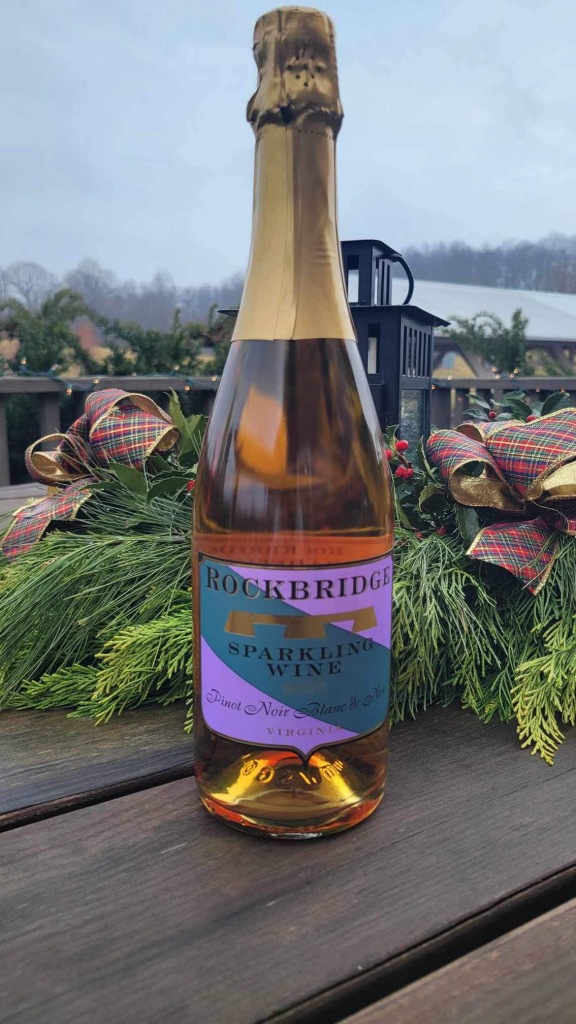
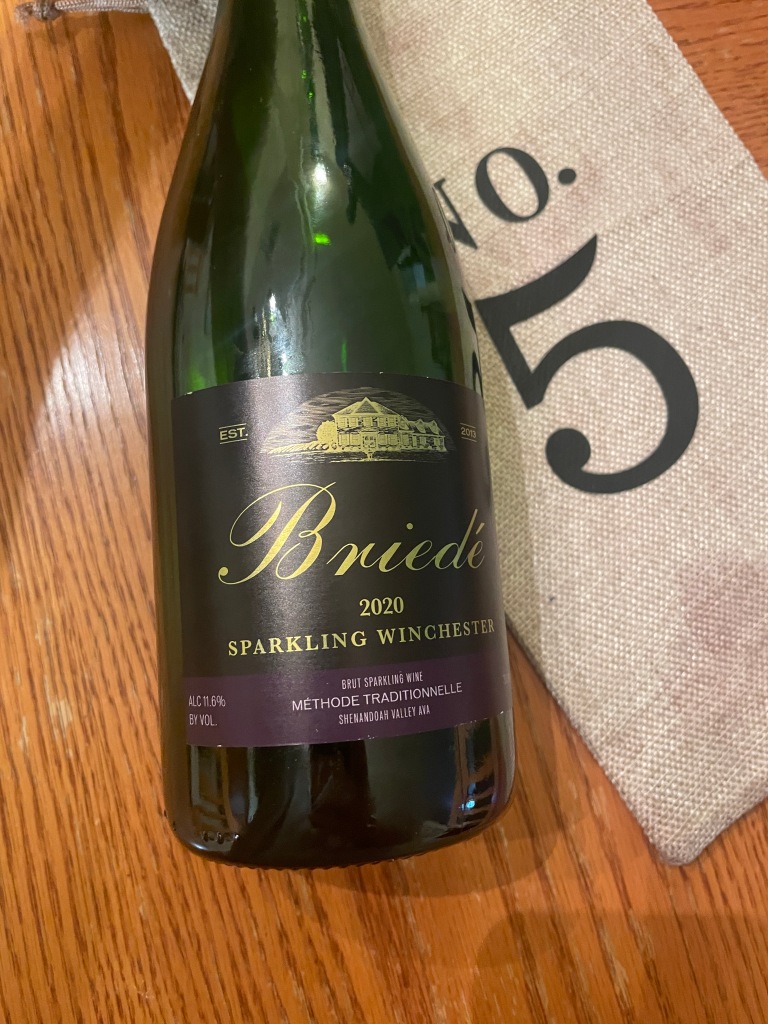
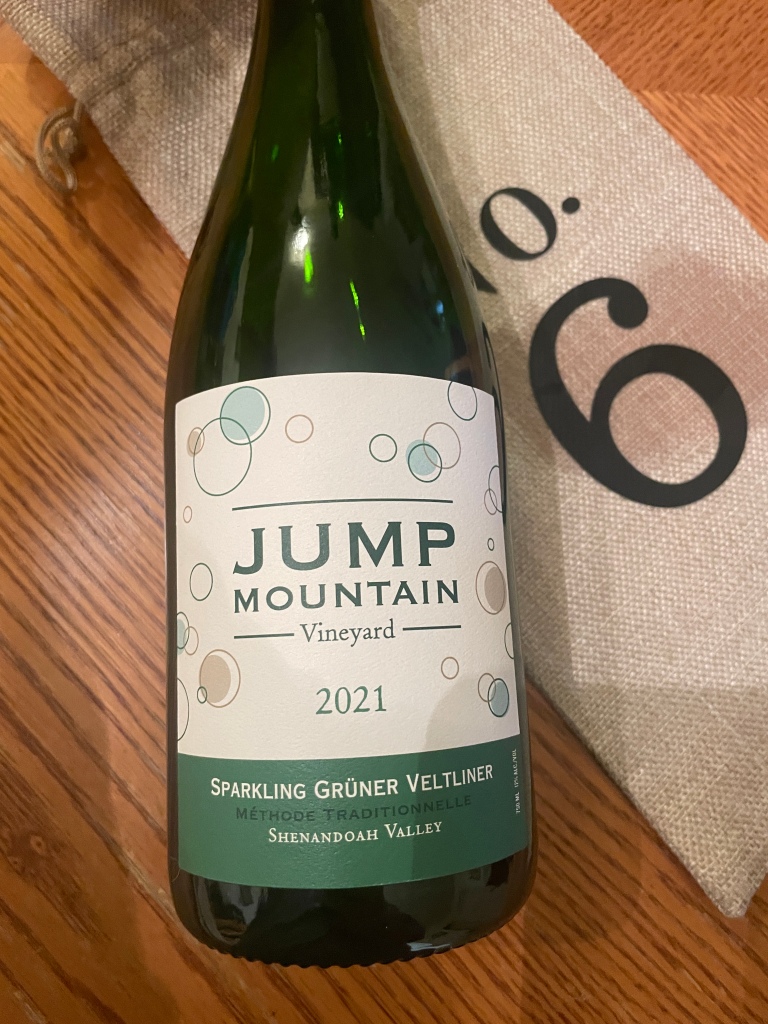
This round was our most diverse lineup of the day, as we had a Pinot Noir, Cayuga, and Grüner Veltliner side-by-side.
People kept coming back to the color of the Rockbridge Blanc de Noirs, which was possibly the prettiest wine of the day. I contacted winemaker Shep Rouse and learned it was all from the initial press.
As you might expect from a diverse lineup, our tasting notes were all over the place. It didn’t help that I overly-chilled these wines, so they took extra-long for our bottles to warm up (note to self; don’t leave your sparkling in the fridge too long).
Bottle #4: Rockbridge 2020 Blanc de Noirs: Too many different notes to capture! We were very curious what it was as it had one of the prettiest colors of the day. For the most part, the nose followed the palate.
Nose reminded someone of daffodil; a few mentioned it had a lovely toastiness with some orange peel. Others got some caramel and honey butter. Maybe there was a little RS here. One person mentioned ‘dissected red apple’.
Bottle #5: Briedé 2020 Sparkling Winchester (Cayuga): Lot of notes here as well, although leaning more towards herbal notes than fruit ones. Being served overly cold didn’t do it any favors. One of the highest acid wines of the day.
“Chicken bullion” nose. Thin; maybe some herbs including thyme and ginger. Notes of yellow flower and chamomile. “Ripping acidity”. Maybe notes of Myer lemon.
Bottle #6: Jump Mountain 2021 Grüner Veltliner: “Intriguing” was often used. More approachable on the palate than the nose. I felt it needed food and time to open up.
Various descriptors included a brioche nose; notes of vanilla, almond, and lime were also mentioned. A few felt it had a Riesling-like petrol nose (which was close; Riesling and Grüner are related). Another person said it had an apple juice quality to it (but in a good way).
Votes:
- Alex: 4/5/6. Felt #4 was ‘artisanal’
- Chrisa: Thought #4 was delicious and complex but preferred it on its own, not with food.
- Kathy: 4/5/6 but it was a close call.
- Lieven: 4/6/5. Thought #5 was too herbal for him.
- Matt: 5/6/4. Liked the acidity on #5
- Richard: 5/4/6
- Sharneen: 4/5/6. Loved the color of #4, although #5 opened up over time
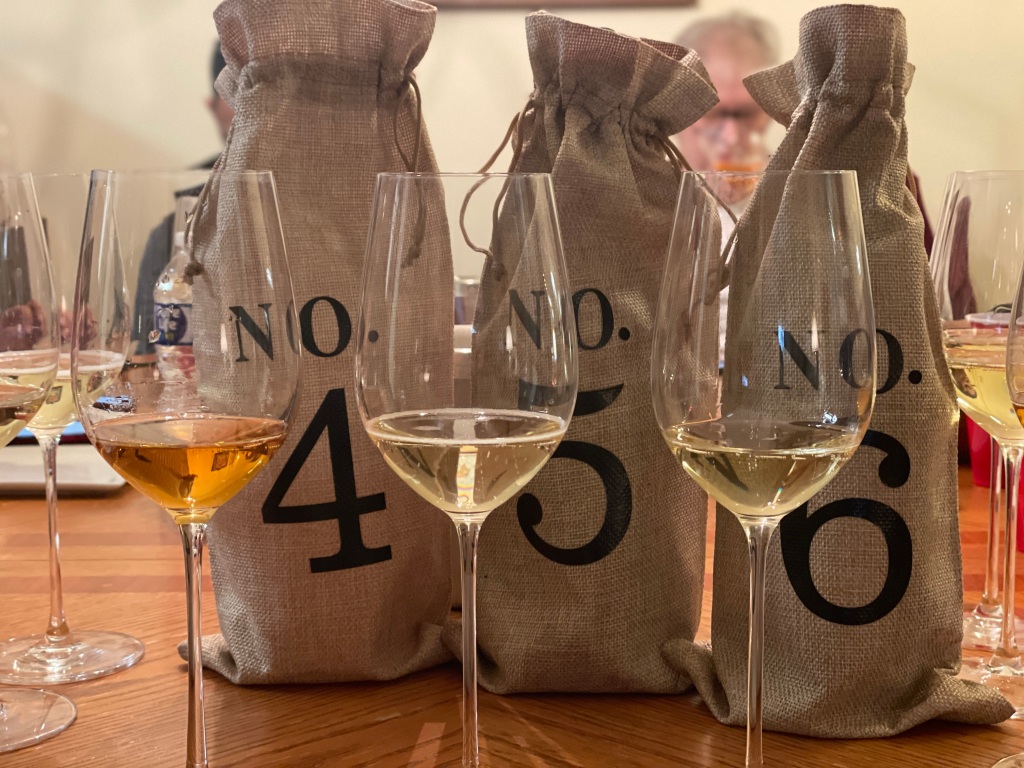
Round 1 / Flight #3:
- Bottle #7: Muse NV Blanc de Blanc
- Bottle #8: CrossKeys 2019 Blanc de Noirs (Round winner)
- Bottle #9: Midland Wine 2018 “Zero” Blanc de Blanc
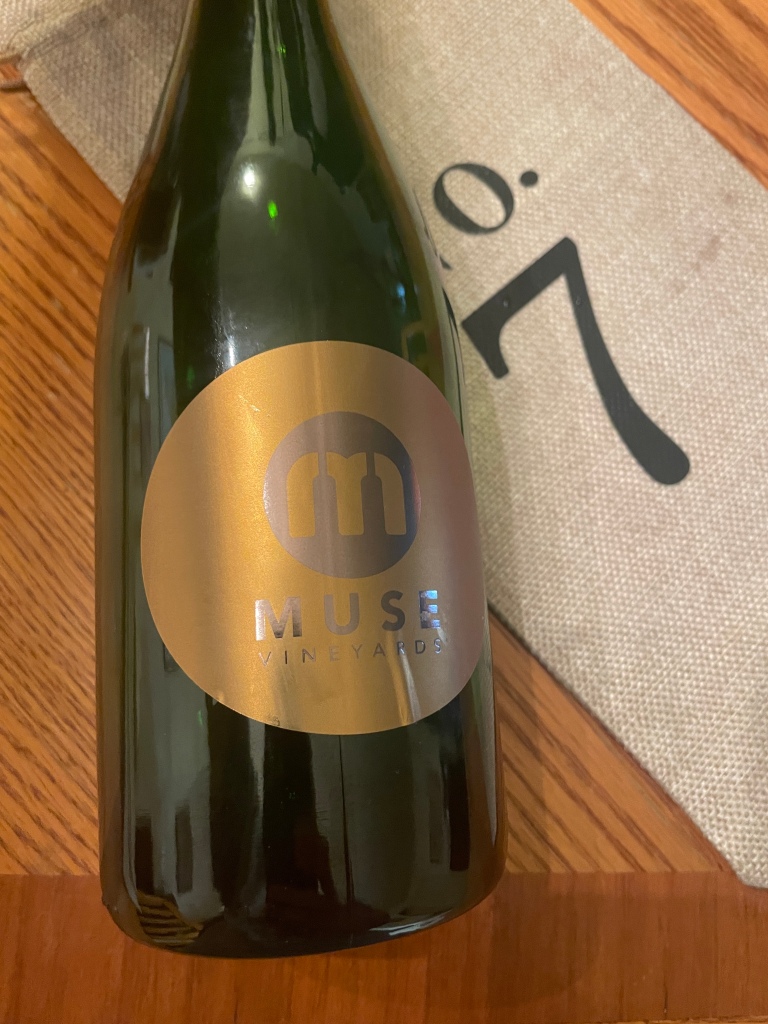

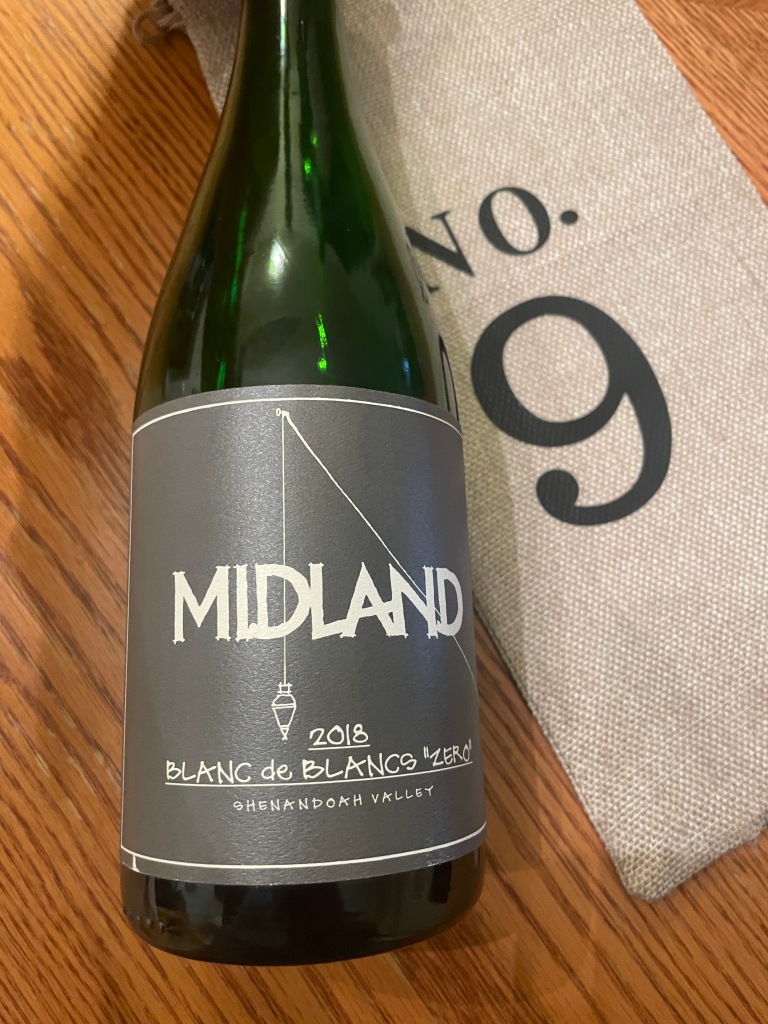
This round took us back to Chardonnay, with the CrossKeys Blanc de Noirs added in.
Loved the nose of #9/Midland, but people’s favorites were all over the place. This being the last round my notes were getting shorter and shorter.
Bottle #7: Muse NV Blanc de Blanc: Had an herbal nose, maybe with some mushroom and minerality. Little reductive. Musty barnyard quality to it (PS – this isn’t a negative; that’s an official tasting note!).
Bottle #8: CrossKeys 2019 Blanc de Noirs: Notes of candied apple, more RS. Palate different from the nose. Little reductive but people didn’t treat that as a negative. Nice minerality and salinity. High acid, apple tart nose. Others said they found “orchard fruit” notes.
Bottle #9: Midland Wine 2018: There were many compliments about its nose. Good complexity, although the nose and palate were different. Good ‘muse’. Notes of fennel, apple, pear. Some bitterness.
Votes:
- Alex: 9/8/7. Found some creaminess on #9.
- Chrisa: 8/9/7
- Kathy: 8/9/7. #8 was simple but enjoyable.
- Lieven: 7/8/9
- Matt: 8/7/9. 8 had the best palate but 9 had the best nose.
- Richard: 8/9/7
- Sharneen: 8/9/7. 8 improved as it opened up and liked the salinity.
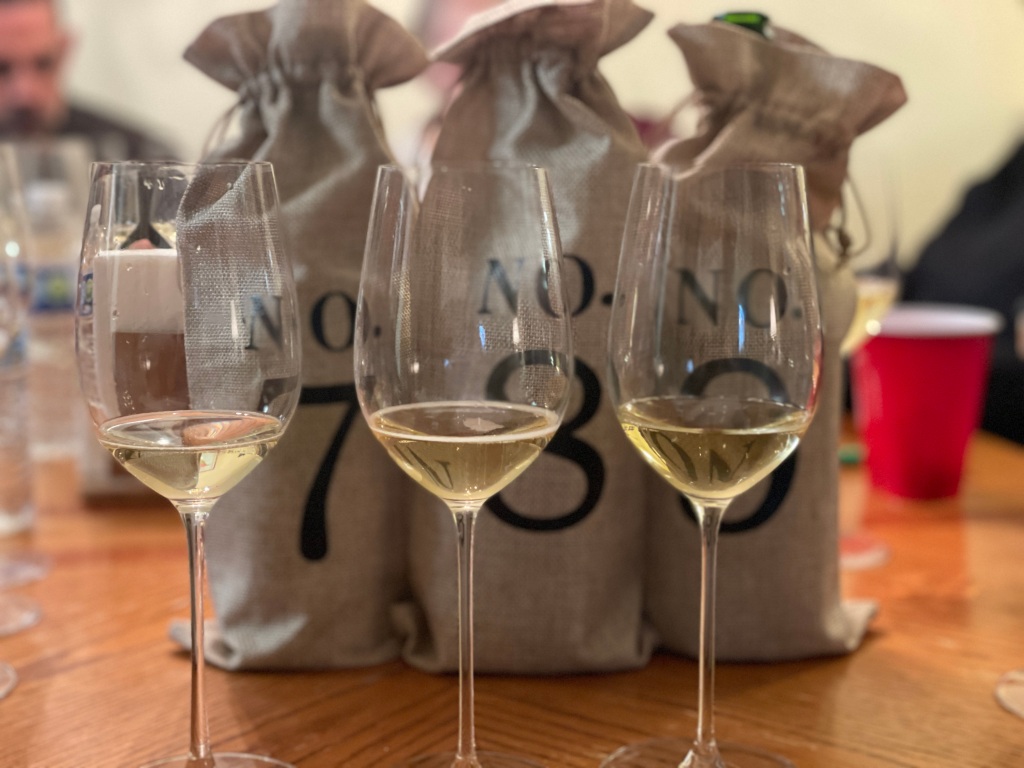
Finalist Round:
- Bottle #3: Bluestone 2017 Blanc de blanc (Runner Up)
- Bottle #4: Rockbridge 2020 Blanc de Noirs
- Bottle #8: CrossKeys 2019 Blanc de Noirs (Finalist)
No new tasting notes here, as we had plenty of notes from earlier. Now that the wines had time to warm up, we were able to enjoy them more.
#3/Bluestone and #8/CrossKeys were generally the favorites, although “where did this color come from?” on #4/Rockbridge seemed to elicit the most discussion as it was the most ‘intriguing’ for several participants, not just for the color but overall tasting profile.
The top two were generally ‘classic’ in profile and was almost a toss-up, and we went with CrossKeys’ 2019 Blanc de Noir as the day’s favorite.
- Alex: 3/4/8. Liked the creaminess of #3.
- Chrisa: 8/4/3. #8 was round, liked the candied apple notes, acidity and balance.
- Kathy: 8/ 3 & 4 tied.
- Lieven: 3/4/ 8. #3 was more classic, #4 was intriguing.
- Matt: 8/3/4. Thought #8 was the most complex.
- Richard: 8/3/4. Chose #8 but was tempted to go with #4 because thought #4 was the most interesting and artisanal.
- Sharneen: 8/4/3. #8 was better as it opened up.

Lessons Learned
I wouldn’t say there were a lot in terms of ‘lessons learned here’. The entire point was to taste wines from the Shenandoah Valley side-by-side as opposed to comparing it to a different wine region, as well as giving exposure to these wines to some local industry folks.
But if there was a ‘surprise’ of the day, it was the Rockbridge Blanc de Noirs. I asked several people what wine ‘most surprised them’, this was often the most mentioned bottle. That color just stood out, plus the tasting notes kept people talking.
The overall favorites of the day were either CrossKeys 2019 Blanc de Noirs or the Bluestone 2017 Blanc de Blanc; not surprisingly these were the #1 and #2 choices in our tiered tasting.
The Bluestone was 100% Chardonnay, 4 years en triage (the stage where a still wine slowly converts into a sparkling one), made in all stainless. Lee explained how the first time he made his sparkling he had assistance from Veritas for the disgorging, but now he does everything by hand.
That the CrossKeys Blanc de Noirs was the favorite is hardly surprising, as this was selected by Atlantic Seaboard Competition as their 2022 Best in Show. This wine was fermented and aged for 8 months in barrel with continuous lees stirring then fined, filtered, and bottled, then aged in bottles for another 16 months to develop mature.
This is also one of the relatively few vineyards that grow Pinot Noir (2.5 acres) in the state, which makes it extra special for a Virginia wine lovers.

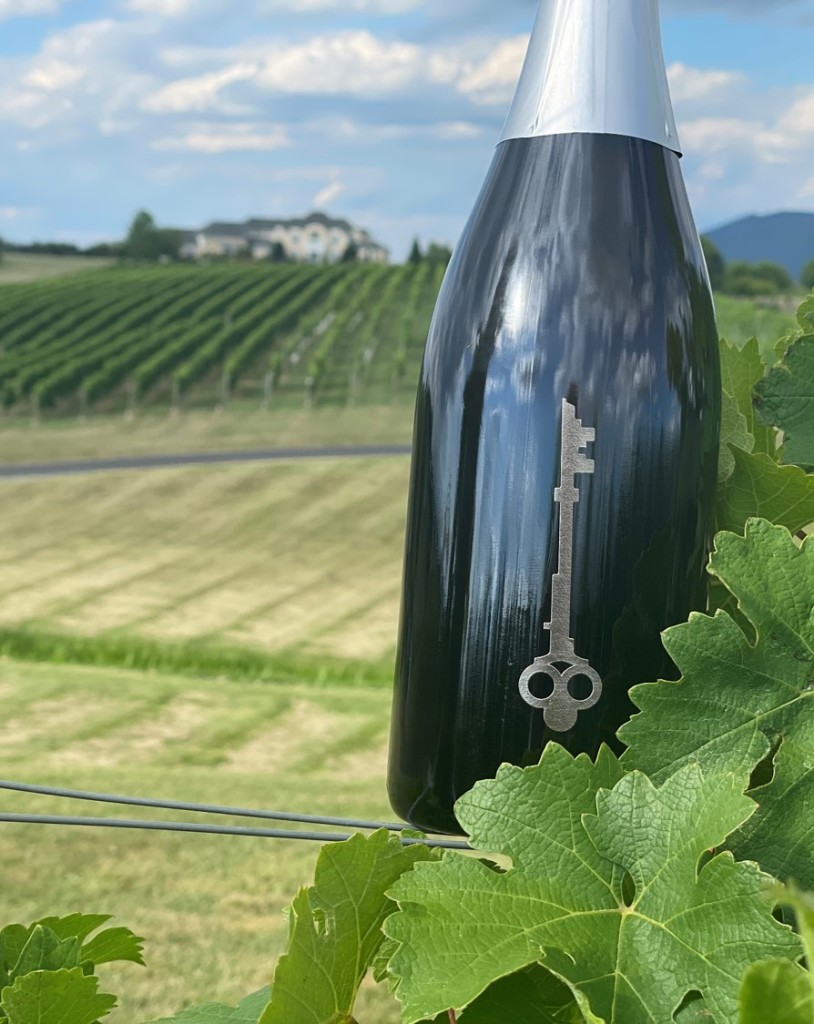

Sounds like a really great event, and I think I want to try all of those :).
LikeLike